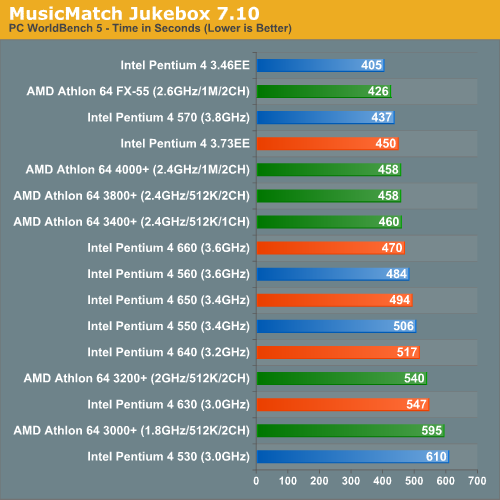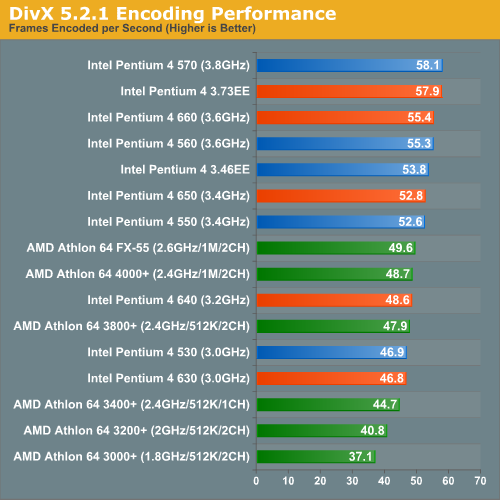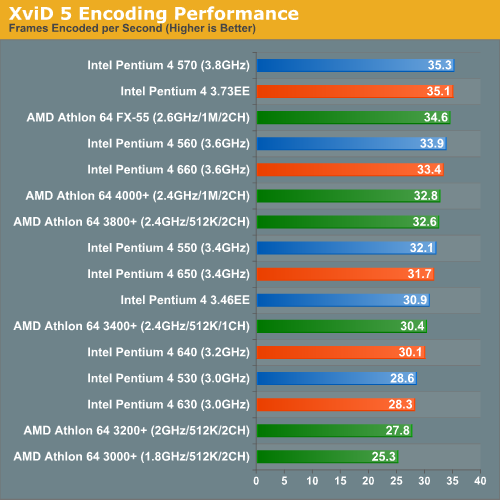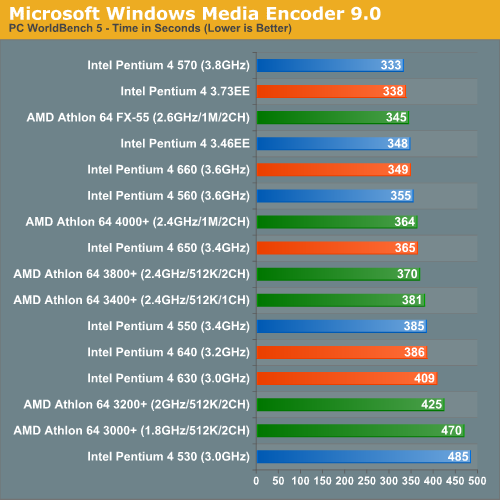Intel Pentium 4 6xx and 3.73EE: Favoring Features Over Performance
by Anand Lal Shimpi & Derek Wilson on February 21, 2005 6:15 AM EST- Posted in
- CPUs
Audio/Video Encoding
MusicMatch Jukebox 7.10

DivX 5.2.1 with AutoGK
Armed with the DivX 5.2.1 and the AutoGK front end for Gordian Knot, we took all of the processors to task at encoding a chapter out of Pirates of the Caribbean. We set AutoGK to give us 75% quality of the original DVD rip and did not encode audio.

XviD with AutoGK
Another very popular codec is the XviD codec, and thus we measured encoding performance using it instead of DivX for this next test. The rest of the variables remained the same as the DivX test.

Windows Media Encoder 9
To finish up our look at Video Encoding performance we've got two tests both involving Windows Media Encoder 9. The first test is WorldBench 5's WMV9 encoding test.

But once we crank up the requirements a bit and start doing some HD quality encoding under WMV9 the situation changes dramatically:











71 Comments
View All Comments
L3p3rM355i4h - Monday, February 21, 2005 - link
#30 90mm SOI= lower wattage.Brian23 - Monday, February 21, 2005 - link
Look at the power consumption graph for the A64. Why is the 3500 winchester doing so much better than the 3000 and 3200 winchesters?L3p3rM355i4h - Monday, February 21, 2005 - link
#28 saw almost the same thing at PCPER too.Aenslead - Monday, February 21, 2005 - link
I could ALMOST swear I saw the VERY same bencmarks last night @ xbit labs... fancy that.bldckstark - Monday, February 21, 2005 - link
227 WATTS!!... My daughter has a crayon maker. It uses a 60W light bulb in a plastic box to melt 3 crayons and pours them into a mold. It melts the wax in about 5 minutes. If I buy a P4 I can melt 11.35 crayons at once. It uses 3.78 times as much energy as is necessary to light my computer room. This is not efficient use of resources.L3p3rM355i4h - Monday, February 21, 2005 - link
sorry to go off topic, but are the forums down or does this terminal suck?LoneWolf15 - Monday, February 21, 2005 - link
From a price/performance standpoint, I can't see many good reasons to buy a P4 six series, and in many cases, a five series either (exceptions being high-end 3D rendering apps and heavy video encoding). Not just because of what price of processor (which doesn't seem to net a huge speed increase) but the increased power draw means a heavier power supply, plus more expensive cooling. Compared to the lower power draw of the Athlon 64 CPU's, as well as a lower price at least at the entry-to-mid level CPU's, I think Intel really needs to go back to basics and create a new CPU architecture.mlittl3 - Monday, February 21, 2005 - link
Okay, I have an addition to my last comment made about the Extreme Edition being a scam. I did some calculations that were left out my anandtech to see if the 3.73EE is truely better than the 3.46EE.Everyone knows the differences between the two processors. The 3.73EE has an 8% increase in CPU speed, less total cache overall but 4x the lower latency L2 cache when compared to L3 cache (the XD-bit and EM64T are also added but that will not effect performance at all with 32-bit OS).
With these added features, the 3.73EE should be better than the 3.46EE especially since the Prescott core is supposed to scale well with clock speed versus the Gallatin/Northwood and the 1066 MHz FSB is supposed to give better performance at higher clock speeds. Well, let's look at the numbers.
Using Anandtech's results, I calculated the % difference between the two processors. They varied between -10 (worse) and 30 % (better). I then added up all the scores (I took the inverse of the less is better scores) and divided them by the introduction price ($999) and the MHz of each processor. Here are the results.
Performance per $:
3.46EE - 20.69
3.73EE - 20.61
Performance per MHz:
3.46EE - 5.96
3.73EE - 5.52
You can do the calculations yourself by using all the benchmark numbers from the two extreme edition CPUs in the review. As you can see, the 3.73EE is worse on a per dollar and per MHz basis compared to the 3.46EE (even though the margin is small, it is still worse for the higher clocked CPU). The Prescott core is a failure IMHO. The 3.73EE is a total scam and the extreme edition processors in general are poor performers. Remember these were released just to offset the marketing of AMD FX processors when Intel got wind of them 1.5 years ago. I don't think Intel was ever going to release them and they keep getting worse and worse.
A scam alert should be issued. Buyer beware!
L3p3rM355i4h - Monday, February 21, 2005 - link
Ho Hum, intel is still stagnating. 227 watts load? Jeezus, thats incredible.mlittl3 - Monday, February 21, 2005 - link
Just a quick, possible correction.I don't know if you meant to or not, but the comparison of the Prescott vs. Prescott 2M table is missing Windows Media Creator HD and Visual Studio results.